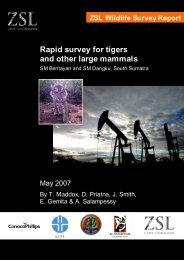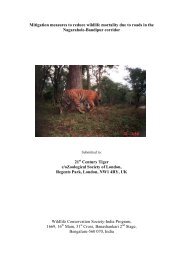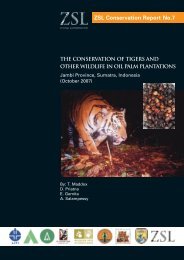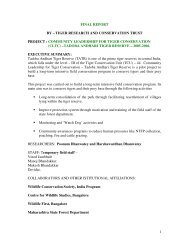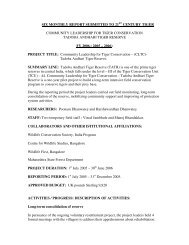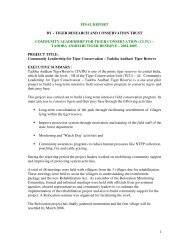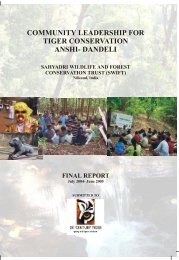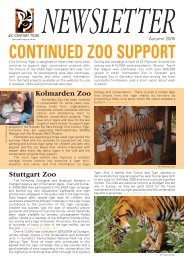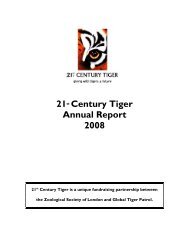WCS long term research final report 2006 - 21st Century Tiger
WCS long term research final report 2006 - 21st Century Tiger
WCS long term research final report 2006 - 21st Century Tiger
Create successful ePaper yourself
Turn your PDF publications into a flip-book with our unique Google optimized e-Paper software.
The Amur or Siberian tiger (Panthera tigris altaica) is a classic landscape species, ranging<br />
across a variety of human-influenced landscapes, and competing with people for critical<br />
habitat and resources. Their population has been at perilously low levels, and in the Russian<br />
Far East (RFE) international efforts to save them from extinction have been ongoing for more<br />
than a decade. In recent years—partly due to <strong>WCS</strong>’s 13-year-<strong>long</strong> efforts—the tiger has<br />
begun to show signs of recovery. Poaching has declined, and improved scientific<br />
understanding of the species’ requirements has enabled planners to take actions including: 1)<br />
protected area planning and management; 2) establishment of protected areas in China; 3)<br />
establishment of a legal basis for corridors between protected areas; 4) road closures to<br />
reduce mortality of tigers and their prey; 5) management of game populations outside<br />
protected areas to benefit both humans and tigers; 6) education and outreach to ensure a local<br />
understanding of the role tigers play in the ecosystem; 7) bi-lateral discussions to establish<br />
transboundary reserves to connect tiger populations in the RFE and northeast China; and 8)<br />
efforts to reestablish viable tiger populations in China. However, despite 13 years of<br />
<strong>research</strong>, there are at least five key reasons why we feel the Siberian <strong>Tiger</strong> Project (STP)<br />
must continue.<br />
1. Data are lacking in several areas (e.g., cub survival and causes of cub mortality, dispersal,<br />
and predation rates). These data have proven extremely difficult to obtain. While<br />
significant progress has been made in recent years, continuing efforts are necessary to<br />
complete our understanding of these key features of tiger biology.<br />
2. Long-<strong>term</strong> radio telemetry and monitoring studies provide invaluable insights into tiger<br />
ecology and conservation that cannot be derived from short-<strong>term</strong> studies. For instance,<br />
results from 2004 suggest that when tigers are well protected from poaching not only do<br />
survivorship and reproduction increase, but density of adult females may also increase by<br />
as much as 100%. Further monitoring is needed to de<strong>term</strong>ine if the system can support the<br />
current high densities and reproduction in our core study area.<br />
3. We are formalizing and expanding our efforts to prepare the next generation of<br />
conservation biologists in the RFE, as well as international conservation biologists, using<br />
the STP as a vehicle for intensive field training and as an introduction to the problems of<br />
international conservation efforts. This includes the construction of the Sikhote-Alin<br />
Research Center.<br />
4. Inspection <strong>Tiger</strong> (Ministry of Natural Resources, Russian Federation) relies on our skilled<br />
staff to assist with tiger-human conflicts. Despite continuing efforts to train Inspection<br />
<strong>Tiger</strong> staff, turnover and inconsistencies in the organization have limited their capacity to<br />
become self-sufficient.<br />
5. Results of our <strong>research</strong> demonstrate our competence as biologists, and provide a strong<br />
platform for making conservation recommendations. As a conservation entity in the RFE,<br />
<strong>WCS</strong> is unique in that our work is science-based. This gives us a powerful position in<br />
discussions of conservation questions, because we are the only organization with such a<br />
wealth of knowledge and understanding of tiger ecology. The continuation of the STP is<br />
critical to maintaining our position as a leader in the conservation community here and<br />
enables us to ensure that science-based recommendations are included in the dialog on<br />
how to proceed with tiger conservation in Russia.<br />
2




